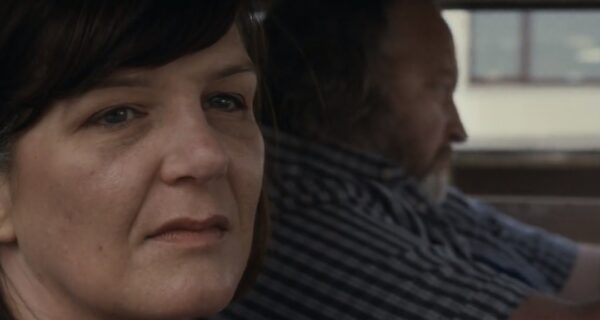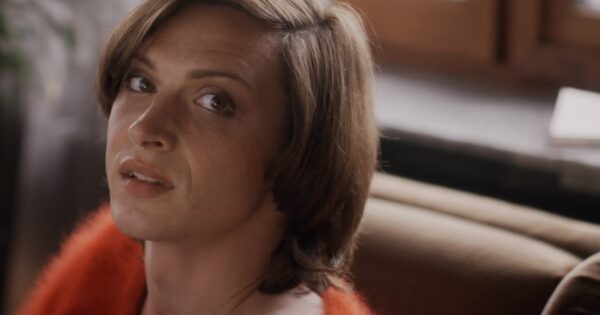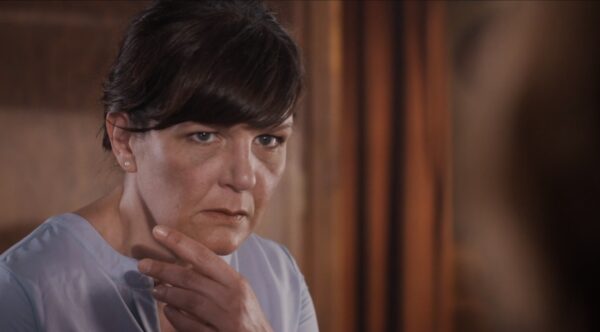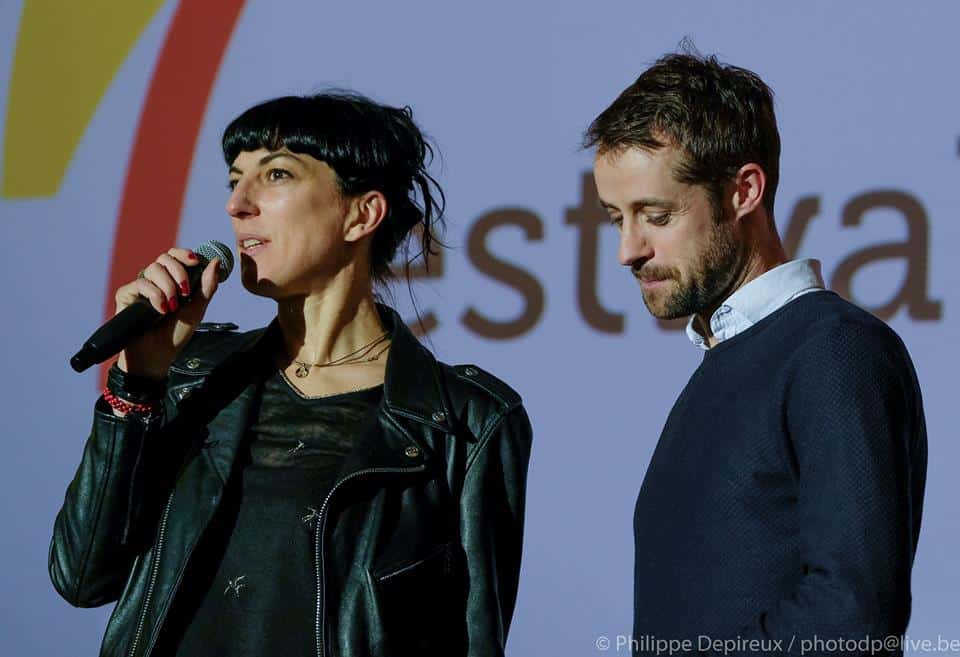IRIS PRIZE – CALAMITY
The Iris Blogger caught up with co-director Maxime Feyers to talk about his Iris Prize nominated short film.
Calamity is a sharply observed bittersweet comedy of manners centred around a mother's reaction to the news that her son's new girlfriend, Cléo, is transgender. It was directed by the team of Maxime Feyers and Séverine de Streyker (pictured above), and is one of the 35 short films from around the world nominated for this year's Iris Prize.
IRIS BLOGGER : Calamity is told from the family's (and especially the mother's) point of view, rather than Cléo and Michael's. Was that always the plan?
 MAXIME FEYERS :
MAXIME FEYERS : We wanted the mother to be the main character as we thought more viewers could project themselves in the character. We think most people can imagine that someone in their surrounding could live this situation. We wanted to reach a larger audience, including – but not only – the LGBT+ community. The idea was to talk to an audience that maybe doesn't know anything about transgender people, and we thought most people could identify with the members of this family, as they meet Cléo for the first time.
IB : Cléo, a trans woman, is played by François Maquet, a cisgender male actor. There's been some controversy in recent years about cisgender actors playing transgender roles, and one of our panels this year is on the casting of LGBT+ parts in film. Do you have any thoughts on this?
MF : In the beginning our idea was simply to find an actor, like for any other role. We posted a casting call and received many applications. Very early on we met François and were totally seduced. Also, Cléo is at the very beginning of her transition and we wanted to keep the ambiguity (of gender), which would have been harder to depict with a trangsender actor, I think, as there would no longer be that ambiguity.
 IB: France's reaction to Cléo is very subtle and nuanced - we're never quite sure whether it's confusion, attraction, envy or distrust - and this is never entirely resolved. Did that come from the script, or did any of it it develop from Ingrid Heiderscheidt's involvement?
MF :
IB: France's reaction to Cléo is very subtle and nuanced - we're never quite sure whether it's confusion, attraction, envy or distrust - and this is never entirely resolved. Did that come from the script, or did any of it it develop from Ingrid Heiderscheidt's involvement?
MF : It was the intention from the start. We wanted to explore her mind, her reactions, and the idea that many contradictory reactions occur inside in the same time. We wanted to show that she passes through phases.
It is not entirely resolved but at the end we can see that France has evolved and that there is hope. Also she goes from a situation where the focus is on Cléo to a situation where she also questions her own identity, as a mother, as a wife…
IB : It's an amazing performance - how much of a part did she have in building the character?
MF : Ingrid is able to give her characters a very complex texture. She is able to shift from one emotion to another very quickly, she is also able to express mixed and opposite emotions at the same time. She was perfect for the role, she went further than we expected, it was a really exciting and rewarding experience to work with her. She's been really generous and it was an amazing gift for us.
IB : At one point, we enter the father's daydreams as he imagines Cléo performing a musical number. Even though we spend more time with the mother, we don't enter her mind as directly - it's left to the audience to read her thoughts. Was it a conscious decision to make the father's thoughts explicit and the mother's more ambiguous?
 MF :
MF : It was our wish to develop the mother’s character with more subtlety, more mystery. As her first reaction is denial, she cannot even rely on her conscious feelings and is taken on a confusing journey. So her reactions, especially in the beginning, are more intricate, less clear. The other characters, like the brother and the father are less complex, their reaction are more one-sided. It is a short film and we don’t have as much time for all characters even if, regarding the father, he also has several layers that he reveals towards the end of the film, where he also shows another side of his personality, more sensitive and poetic.
IB : There are moments that are very elegant and stylised - I'm thinking particularly of a moment when Agathe's profile seems to merge with Cléo's face. What were Calamity's major influences?
MF : In the process of filmmaking, what interests us is to create a particular universe, not only depicting reality as it is. We like to look at what lies behind the surface. We like when reality is distorted and stands alongside with a sense of unreal, of magic, unveiling and exploring the unconscious part of our character’s souls.
We are influenced by directors like David Lynch, Vincent Gallo, Stanley Kubrick. We attach importance to the colours, the contrast, we wanted to work in a low key environments for all the scenes taking place upstairs and in the basement. This particular scene, with the two girls, was also inspired by Bergman’s aesthetics. We tried to create moments where movement and choreography tell the story and the feelings.
Also we wanted the house to be a character in itself and we paid attention to every detail together with our art department crew.
IB : You're visiting Cardiff for this year's Festival - what are you most looking forward to?
MF : It is really exciting to be on the shortlist. We're looking forward to discovering the other films and meeting other filmmakers and the audience. It's our first time in Wales so we are also looking forward to discovering the area too. The festival seems very welcoming and it looks like it will be a very friendly experience.
 MAXIME FEYERS : We wanted the mother to be the main character as we thought more viewers could project themselves in the character. We think most people can imagine that someone in their surrounding could live this situation. We wanted to reach a larger audience, including – but not only – the LGBT+ community. The idea was to talk to an audience that maybe doesn't know anything about transgender people, and we thought most people could identify with the members of this family, as they meet Cléo for the first time.
IB : Cléo, a trans woman, is played by François Maquet, a cisgender male actor. There's been some controversy in recent years about cisgender actors playing transgender roles, and one of our panels this year is on the casting of LGBT+ parts in film. Do you have any thoughts on this?
MF : In the beginning our idea was simply to find an actor, like for any other role. We posted a casting call and received many applications. Very early on we met François and were totally seduced. Also, Cléo is at the very beginning of her transition and we wanted to keep the ambiguity (of gender), which would have been harder to depict with a trangsender actor, I think, as there would no longer be that ambiguity.
MAXIME FEYERS : We wanted the mother to be the main character as we thought more viewers could project themselves in the character. We think most people can imagine that someone in their surrounding could live this situation. We wanted to reach a larger audience, including – but not only – the LGBT+ community. The idea was to talk to an audience that maybe doesn't know anything about transgender people, and we thought most people could identify with the members of this family, as they meet Cléo for the first time.
IB : Cléo, a trans woman, is played by François Maquet, a cisgender male actor. There's been some controversy in recent years about cisgender actors playing transgender roles, and one of our panels this year is on the casting of LGBT+ parts in film. Do you have any thoughts on this?
MF : In the beginning our idea was simply to find an actor, like for any other role. We posted a casting call and received many applications. Very early on we met François and were totally seduced. Also, Cléo is at the very beginning of her transition and we wanted to keep the ambiguity (of gender), which would have been harder to depict with a trangsender actor, I think, as there would no longer be that ambiguity.
 IB: France's reaction to Cléo is very subtle and nuanced - we're never quite sure whether it's confusion, attraction, envy or distrust - and this is never entirely resolved. Did that come from the script, or did any of it it develop from Ingrid Heiderscheidt's involvement?
MF : It was the intention from the start. We wanted to explore her mind, her reactions, and the idea that many contradictory reactions occur inside in the same time. We wanted to show that she passes through phases.
It is not entirely resolved but at the end we can see that France has evolved and that there is hope. Also she goes from a situation where the focus is on Cléo to a situation where she also questions her own identity, as a mother, as a wife…
IB : It's an amazing performance - how much of a part did she have in building the character?
MF : Ingrid is able to give her characters a very complex texture. She is able to shift from one emotion to another very quickly, she is also able to express mixed and opposite emotions at the same time. She was perfect for the role, she went further than we expected, it was a really exciting and rewarding experience to work with her. She's been really generous and it was an amazing gift for us.
IB : At one point, we enter the father's daydreams as he imagines Cléo performing a musical number. Even though we spend more time with the mother, we don't enter her mind as directly - it's left to the audience to read her thoughts. Was it a conscious decision to make the father's thoughts explicit and the mother's more ambiguous?
IB: France's reaction to Cléo is very subtle and nuanced - we're never quite sure whether it's confusion, attraction, envy or distrust - and this is never entirely resolved. Did that come from the script, or did any of it it develop from Ingrid Heiderscheidt's involvement?
MF : It was the intention from the start. We wanted to explore her mind, her reactions, and the idea that many contradictory reactions occur inside in the same time. We wanted to show that she passes through phases.
It is not entirely resolved but at the end we can see that France has evolved and that there is hope. Also she goes from a situation where the focus is on Cléo to a situation where she also questions her own identity, as a mother, as a wife…
IB : It's an amazing performance - how much of a part did she have in building the character?
MF : Ingrid is able to give her characters a very complex texture. She is able to shift from one emotion to another very quickly, she is also able to express mixed and opposite emotions at the same time. She was perfect for the role, she went further than we expected, it was a really exciting and rewarding experience to work with her. She's been really generous and it was an amazing gift for us.
IB : At one point, we enter the father's daydreams as he imagines Cléo performing a musical number. Even though we spend more time with the mother, we don't enter her mind as directly - it's left to the audience to read her thoughts. Was it a conscious decision to make the father's thoughts explicit and the mother's more ambiguous?
 MF : It was our wish to develop the mother’s character with more subtlety, more mystery. As her first reaction is denial, she cannot even rely on her conscious feelings and is taken on a confusing journey. So her reactions, especially in the beginning, are more intricate, less clear. The other characters, like the brother and the father are less complex, their reaction are more one-sided. It is a short film and we don’t have as much time for all characters even if, regarding the father, he also has several layers that he reveals towards the end of the film, where he also shows another side of his personality, more sensitive and poetic.
IB : There are moments that are very elegant and stylised - I'm thinking particularly of a moment when Agathe's profile seems to merge with Cléo's face. What were Calamity's major influences?
MF : In the process of filmmaking, what interests us is to create a particular universe, not only depicting reality as it is. We like to look at what lies behind the surface. We like when reality is distorted and stands alongside with a sense of unreal, of magic, unveiling and exploring the unconscious part of our character’s souls.
We are influenced by directors like David Lynch, Vincent Gallo, Stanley Kubrick. We attach importance to the colours, the contrast, we wanted to work in a low key environments for all the scenes taking place upstairs and in the basement. This particular scene, with the two girls, was also inspired by Bergman’s aesthetics. We tried to create moments where movement and choreography tell the story and the feelings.
Also we wanted the house to be a character in itself and we paid attention to every detail together with our art department crew.
IB : You're visiting Cardiff for this year's Festival - what are you most looking forward to?
MF : It is really exciting to be on the shortlist. We're looking forward to discovering the other films and meeting other filmmakers and the audience. It's our first time in Wales so we are also looking forward to discovering the area too. The festival seems very welcoming and it looks like it will be a very friendly experience.
MF : It was our wish to develop the mother’s character with more subtlety, more mystery. As her first reaction is denial, she cannot even rely on her conscious feelings and is taken on a confusing journey. So her reactions, especially in the beginning, are more intricate, less clear. The other characters, like the brother and the father are less complex, their reaction are more one-sided. It is a short film and we don’t have as much time for all characters even if, regarding the father, he also has several layers that he reveals towards the end of the film, where he also shows another side of his personality, more sensitive and poetic.
IB : There are moments that are very elegant and stylised - I'm thinking particularly of a moment when Agathe's profile seems to merge with Cléo's face. What were Calamity's major influences?
MF : In the process of filmmaking, what interests us is to create a particular universe, not only depicting reality as it is. We like to look at what lies behind the surface. We like when reality is distorted and stands alongside with a sense of unreal, of magic, unveiling and exploring the unconscious part of our character’s souls.
We are influenced by directors like David Lynch, Vincent Gallo, Stanley Kubrick. We attach importance to the colours, the contrast, we wanted to work in a low key environments for all the scenes taking place upstairs and in the basement. This particular scene, with the two girls, was also inspired by Bergman’s aesthetics. We tried to create moments where movement and choreography tell the story and the feelings.
Also we wanted the house to be a character in itself and we paid attention to every detail together with our art department crew.
IB : You're visiting Cardiff for this year's Festival - what are you most looking forward to?
MF : It is really exciting to be on the shortlist. We're looking forward to discovering the other films and meeting other filmmakers and the audience. It's our first time in Wales so we are also looking forward to discovering the area too. The festival seems very welcoming and it looks like it will be a very friendly experience. 
